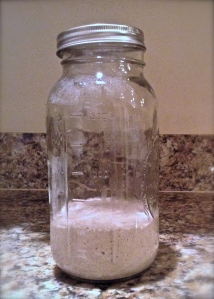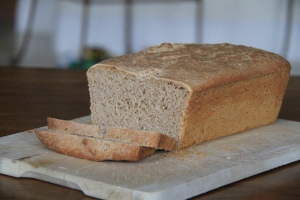I finally took the plunge and started the process of making sourdough bread. From scratch. No cheating, no little bit of yeast to speed up the process, no starting kit or borrowed starters to get the process going. I made my own starter from water, flour and patience. And I was lucky – because my very first starter doubled in size within two days on the counter – and smelled perfectly sour.
What a thrill! Oh, amazing nature – I feel so blessed. I feel like a scientist experiencing an overwhelming satisfaction of the outcome of an experiment. So, so simple – yet such a complex and fascinating event. Wow!
So I got my starter – that was easy. And now what ….?
Yeah, that is the big question.
My kitchen in hot and humid Florida provides a perfect environment for capturing wild yeast, especially since I’ve baking bread regularly for the past year. I have four pots of sourdough starters in my fridge now – but no great bread to talk about.
Not that I haven’t been baking. Believe me I have. But this new process brings me back to square one, I just can’t seem get it right … Two of my sourdough loafs came out very tasty, but odd looking. One was flat like a pancake. One far to dense. One was too sour. One was too pale. And only one had the right amount of moist and air. Sigh …
I have a nagging urge to achieve a successful outcome, fueled by the thrill of the starters and the frustration of the bread. And the successful outcome is defined by taste, look, smell and texture. They all need to be … if not perfect, then at least desireable. Good thing is – I learn something new for every loaf I make. My goal is to master the technique to an extent where I can make any bread I want from a sourdough starter.
I’ve come to realize a few important notes on my quest to conquer the sourdough skills:
- Browse several sources of information – but don’t trust any of them. The fact is – sourdough is a natural product depending on the conditions and the environment where it is being made. Obviously conditions vary a lot, you can manipulate some of it but far from all. That is the beauty of the process … and for some probably a frustration because most likely, there are no expert guides that can be 100% relied on. Also – you will quickly realize that procedures and information vary a lot – because there are plenty of ways of doing it.
- Pick and choose what seems reasonable and doable in you kitchen. You’ll be surprised how little equipment and supporting gadgets you need to make it work. As long as you trust yourself and learn by doing, you will understand the mechanisms in your environment and then be able to expand and experiment far more than if you cling to specific instructions.
- Do not overcomplicate the process. You really just need flour and water … Although I think some of the information out there make it sound like a daring masterpiece which can put you off before you even start. If it looks impossible to overcome – then find a different site.
- Do some basic time planning. The sourdough needs looong time to rise. I find it practical to make the dough in the evening and leave it to rise over night – then bake it in the morning. That works for me.
- You do not need to buy a starter kit, or special sourdough containers – whatever some expert information sites might say. Why should you spend money at someone else’s flour and water mix when you’ve already decided to make the effort of baking yourself …? Any glass or plastic container with a lid that can be sealed – and not sealed, will do.
Now I could go on with sharing all the interesting stuff I’ve learned about making starters, using them, maintaining them and breaking them – but I will save this for later posts, once my bread starts looking presentable. For now, I’ll share some of the resources I’ve attended to during my process:
Cultures for Health is a very informative website about natural cultures in general. I’ve only been browsing the sourdough section which has a lot of information (almost too much …), and have used this basic recipe as a guide when baking.
King Arthur Flour has plenty of good and easy to follow information about what sourdough is and how to maintain it, and a bunch of recipes.
The kitchn has a step by step guide with lots of pictures on how to make a starter.
Classic Sourdoughs; A Home Bakers Handbook is a very useful book with good recipes, good overview and easy to follow information. This book was a breakthrough for my part because I find the content less intimidating and more accessible than some of the other resources (I bought it at Amazon.)
Baking with Sourdough (Sara Pitzer) is a small leaflet packed with interesting information about sourdough history, how to make and maintain – and recipes.
I use the recipe I found at the cultures for health site as a guide, which goes like this:
- 2⅓ cups fresh sourdough starter
- 3⅓ cup flour
- 1-1½ cup water
- Scant tablespoon salt
But then I prefer the procedure from my Home Baker’s Handbook, or at least close up to this one, where the dough can rise in a bowl over night (at the coolest place in the house, in the hallway on the floor, which keeps around 72 F at night, approximately) and be shaped in the morning. This has brought me closest to a bread I can be satisfied with.
I’m looking forward to posting a sourdough bread that I’m satisfied with. Sourdough is fascinating in so many ways – and apparently healthier than regular bread, which is an encouragement in itself. How can a bread be healthier only due to a technique? I used to think. But the slow process of rising naturally slows down of the process of breaking down the sugar which helps stabilizing the blood sugar response when eating it, I’ve learned.
Rye will still be healthier than plain white wheat though. Sourdough or not.
Have a good weekend.
Categories: Uncategorized
marwinna
I'm Currently living in Florida, USA, but I'm Norwegian born and bred. At the moment I enjoy baking bread and blogging about it. I enjoy blogging in general, because I like writing. But I'm trained as an illustrator, originally ... in England. One day I'll write a book. About bread. And illustrate it myself. Maybe. Life will see.



I’m looking forward to reading more about your sourdough breads and adventures! Sourdough bread making for me would not be as fun or challenging if it were a process that can be easily replicated each time you make a loaf. It will be interesting to read about your discoveries!
Yeah! I guess I’m looking for a sensation of a certain amount of control – just feel pretty sure that I’d like to eat the bread I make when it’s done … 🙂